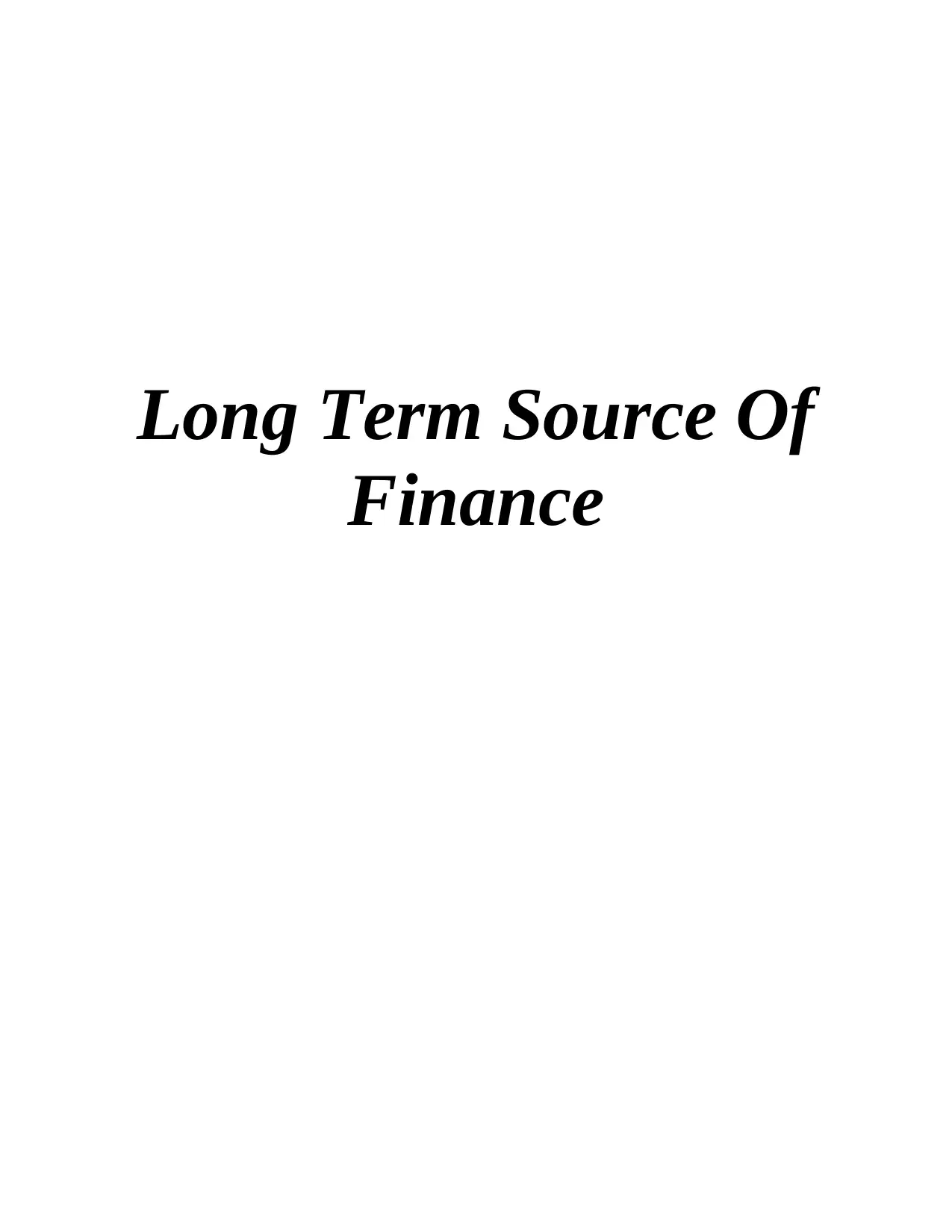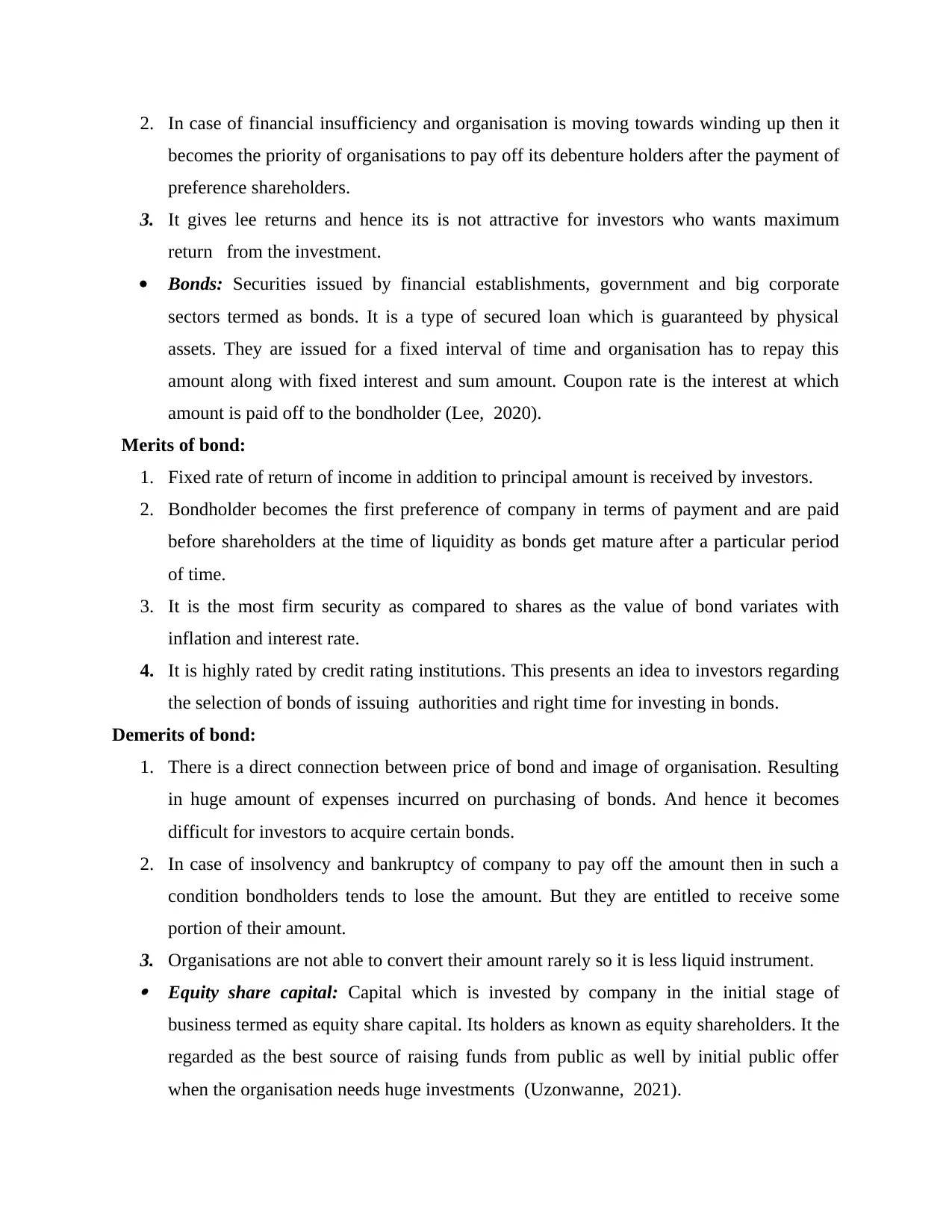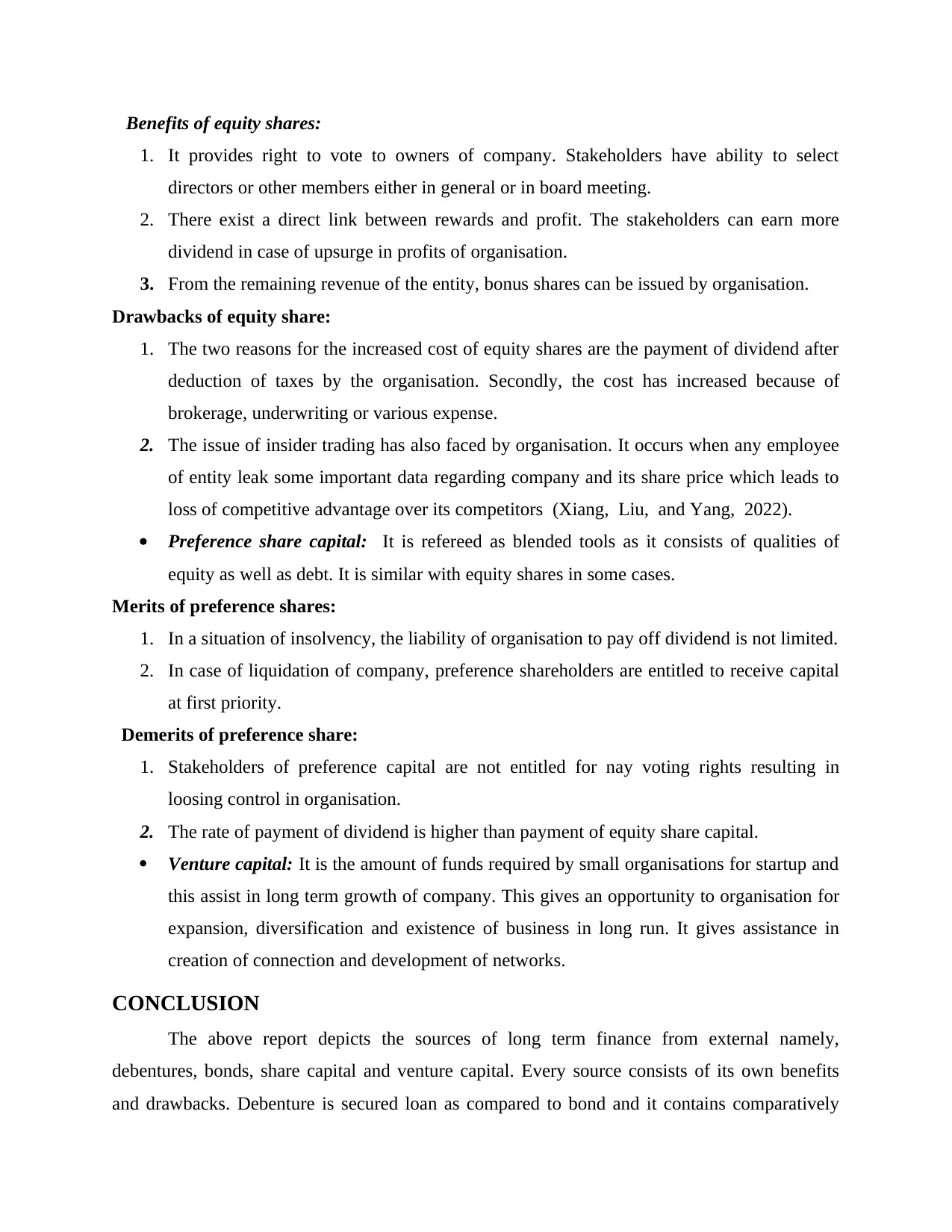Long Term Finance: Sources, Advantages, and Disadvantages
VerifiedAdded on 2023/06/08
|7
|1348
|326
Report
AI Summary
This report provides an overview of long-term finance sources available to organizations, including debentures, bonds, equity share capital, preference share capital, and venture capital. It discusses the advantages and disadvantages of each source, highlighting that debentures are a secured loan with less risk compared to bonds, while equity share capital is a primary and permanent source for investment. Preference shares are presented as a blend of debt and equity, offering a unique set of characteristics. The report concludes that each source has its own benefits and drawbacks, and the choice depends on the specific needs and circumstances of the organization. Desklib provides access to this and other solved assignments for students.

Long Term Source Of
Finance
Finance
Paraphrase This Document
Need a fresh take? Get an instant paraphrase of this document with our AI Paraphraser

Table of Contents
INTRODUCTION ..........................................................................................................................3
MAIN BODY...................................................................................................................................3
1. Sources of long term finance..................................................................................................3
CONCLUSION ...............................................................................................................................5
REFERENCES................................................................................................................................7
INTRODUCTION ..........................................................................................................................3
MAIN BODY...................................................................................................................................3
1. Sources of long term finance..................................................................................................3
CONCLUSION ...............................................................................................................................5
REFERENCES................................................................................................................................7

INTRODUCTION
Long term sources of finance are not payable within a period of one year and generally
becomes a part of the capital of the organisation. They are specifically utilised when company is
planning for its growth and expansion. Some of the examples of long term sources of finance are
equity, term loans, and venture capital. Entrepreneurs come up with capital in the business
through debentures, term loan, bonds, venture capital and by equity and preference shares. For
sole partnership, company the owner is required both short or long term funds for their
establishments (Beckett-Camarata, 2020).
MAIN BODY
1. Sources of long term finance
Debenture: It is an debt tool which assist the organisation in raising funds from public. It
assist the organisation to raise long term funds. Company pays interest in addition with
the principal amount. It is a promissory note which is not secured and is issued by a
private business enterprise without pledging any security or assets.
Advantages of debenture:
1. It is preferred by a number of investors as it is a low risk security.
2. Debenture holders do not contain any voting rights so it is easy for monitoring
management as it does not impacts the rights of equity or preference shareholders.
3. Its financing cost is lower as compared to preference and equity shares. Tax deductions
on payment of interest has also been provided to debenture holders by government.
4. It is beneficial for those investors who want clarity in transaction, risk free and healthy
returns. It is not issued for the purpose of profit.
Disadvantages of debenture:
1. The limit for raising funds has been sanctioned by company. The ability of business to
raise additional funds declines after a period of time (Ervural, Evren, and Delen, 2018).
Long term sources of finance are not payable within a period of one year and generally
becomes a part of the capital of the organisation. They are specifically utilised when company is
planning for its growth and expansion. Some of the examples of long term sources of finance are
equity, term loans, and venture capital. Entrepreneurs come up with capital in the business
through debentures, term loan, bonds, venture capital and by equity and preference shares. For
sole partnership, company the owner is required both short or long term funds for their
establishments (Beckett-Camarata, 2020).
MAIN BODY
1. Sources of long term finance
Debenture: It is an debt tool which assist the organisation in raising funds from public. It
assist the organisation to raise long term funds. Company pays interest in addition with
the principal amount. It is a promissory note which is not secured and is issued by a
private business enterprise without pledging any security or assets.
Advantages of debenture:
1. It is preferred by a number of investors as it is a low risk security.
2. Debenture holders do not contain any voting rights so it is easy for monitoring
management as it does not impacts the rights of equity or preference shareholders.
3. Its financing cost is lower as compared to preference and equity shares. Tax deductions
on payment of interest has also been provided to debenture holders by government.
4. It is beneficial for those investors who want clarity in transaction, risk free and healthy
returns. It is not issued for the purpose of profit.
Disadvantages of debenture:
1. The limit for raising funds has been sanctioned by company. The ability of business to
raise additional funds declines after a period of time (Ervural, Evren, and Delen, 2018).
⊘ This is a preview!⊘
Do you want full access?
Subscribe today to unlock all pages.

Trusted by 1+ million students worldwide

2. In case of financial insufficiency and organisation is moving towards winding up then it
becomes the priority of organisations to pay off its debenture holders after the payment of
preference shareholders.
3. It gives lee returns and hence its is not attractive for investors who wants maximum
return from the investment.
Bonds: Securities issued by financial establishments, government and big corporate
sectors termed as bonds. It is a type of secured loan which is guaranteed by physical
assets. They are issued for a fixed interval of time and organisation has to repay this
amount along with fixed interest and sum amount. Coupon rate is the interest at which
amount is paid off to the bondholder (Lee, 2020).
Merits of bond:
1. Fixed rate of return of income in addition to principal amount is received by investors.
2. Bondholder becomes the first preference of company in terms of payment and are paid
before shareholders at the time of liquidity as bonds get mature after a particular period
of time.
3. It is the most firm security as compared to shares as the value of bond variates with
inflation and interest rate.
4. It is highly rated by credit rating institutions. This presents an idea to investors regarding
the selection of bonds of issuing authorities and right time for investing in bonds.
Demerits of bond:
1. There is a direct connection between price of bond and image of organisation. Resulting
in huge amount of expenses incurred on purchasing of bonds. And hence it becomes
difficult for investors to acquire certain bonds.
2. In case of insolvency and bankruptcy of company to pay off the amount then in such a
condition bondholders tends to lose the amount. But they are entitled to receive some
portion of their amount.
3. Organisations are not able to convert their amount rarely so it is less liquid instrument. Equity share capital: Capital which is invested by company in the initial stage of
business termed as equity share capital. Its holders as known as equity shareholders. It the
regarded as the best source of raising funds from public as well by initial public offer
when the organisation needs huge investments (Uzonwanne, 2021).
becomes the priority of organisations to pay off its debenture holders after the payment of
preference shareholders.
3. It gives lee returns and hence its is not attractive for investors who wants maximum
return from the investment.
Bonds: Securities issued by financial establishments, government and big corporate
sectors termed as bonds. It is a type of secured loan which is guaranteed by physical
assets. They are issued for a fixed interval of time and organisation has to repay this
amount along with fixed interest and sum amount. Coupon rate is the interest at which
amount is paid off to the bondholder (Lee, 2020).
Merits of bond:
1. Fixed rate of return of income in addition to principal amount is received by investors.
2. Bondholder becomes the first preference of company in terms of payment and are paid
before shareholders at the time of liquidity as bonds get mature after a particular period
of time.
3. It is the most firm security as compared to shares as the value of bond variates with
inflation and interest rate.
4. It is highly rated by credit rating institutions. This presents an idea to investors regarding
the selection of bonds of issuing authorities and right time for investing in bonds.
Demerits of bond:
1. There is a direct connection between price of bond and image of organisation. Resulting
in huge amount of expenses incurred on purchasing of bonds. And hence it becomes
difficult for investors to acquire certain bonds.
2. In case of insolvency and bankruptcy of company to pay off the amount then in such a
condition bondholders tends to lose the amount. But they are entitled to receive some
portion of their amount.
3. Organisations are not able to convert their amount rarely so it is less liquid instrument. Equity share capital: Capital which is invested by company in the initial stage of
business termed as equity share capital. Its holders as known as equity shareholders. It the
regarded as the best source of raising funds from public as well by initial public offer
when the organisation needs huge investments (Uzonwanne, 2021).
Paraphrase This Document
Need a fresh take? Get an instant paraphrase of this document with our AI Paraphraser

Benefits of equity shares:
1. It provides right to vote to owners of company. Stakeholders have ability to select
directors or other members either in general or in board meeting.
2. There exist a direct link between rewards and profit. The stakeholders can earn more
dividend in case of upsurge in profits of organisation.
3. From the remaining revenue of the entity, bonus shares can be issued by organisation.
Drawbacks of equity share:
1. The two reasons for the increased cost of equity shares are the payment of dividend after
deduction of taxes by the organisation. Secondly, the cost has increased because of
brokerage, underwriting or various expense.
2. The issue of insider trading has also faced by organisation. It occurs when any employee
of entity leak some important data regarding company and its share price which leads to
loss of competitive advantage over its competitors (Xiang, Liu, and Yang, 2022).
Preference share capital: It is refereed as blended tools as it consists of qualities of
equity as well as debt. It is similar with equity shares in some cases.
Merits of preference shares:
1. In a situation of insolvency, the liability of organisation to pay off dividend is not limited.
2. In case of liquidation of company, preference shareholders are entitled to receive capital
at first priority.
Demerits of preference share:
1. Stakeholders of preference capital are not entitled for nay voting rights resulting in
loosing control in organisation.
2. The rate of payment of dividend is higher than payment of equity share capital.
Venture capital: It is the amount of funds required by small organisations for startup and
this assist in long term growth of company. This gives an opportunity to organisation for
expansion, diversification and existence of business in long run. It gives assistance in
creation of connection and development of networks.
CONCLUSION
The above report depicts the sources of long term finance from external namely,
debentures, bonds, share capital and venture capital. Every source consists of its own benefits
and drawbacks. Debenture is secured loan as compared to bond and it contains comparatively
1. It provides right to vote to owners of company. Stakeholders have ability to select
directors or other members either in general or in board meeting.
2. There exist a direct link between rewards and profit. The stakeholders can earn more
dividend in case of upsurge in profits of organisation.
3. From the remaining revenue of the entity, bonus shares can be issued by organisation.
Drawbacks of equity share:
1. The two reasons for the increased cost of equity shares are the payment of dividend after
deduction of taxes by the organisation. Secondly, the cost has increased because of
brokerage, underwriting or various expense.
2. The issue of insider trading has also faced by organisation. It occurs when any employee
of entity leak some important data regarding company and its share price which leads to
loss of competitive advantage over its competitors (Xiang, Liu, and Yang, 2022).
Preference share capital: It is refereed as blended tools as it consists of qualities of
equity as well as debt. It is similar with equity shares in some cases.
Merits of preference shares:
1. In a situation of insolvency, the liability of organisation to pay off dividend is not limited.
2. In case of liquidation of company, preference shareholders are entitled to receive capital
at first priority.
Demerits of preference share:
1. Stakeholders of preference capital are not entitled for nay voting rights resulting in
loosing control in organisation.
2. The rate of payment of dividend is higher than payment of equity share capital.
Venture capital: It is the amount of funds required by small organisations for startup and
this assist in long term growth of company. This gives an opportunity to organisation for
expansion, diversification and existence of business in long run. It gives assistance in
creation of connection and development of networks.
CONCLUSION
The above report depicts the sources of long term finance from external namely,
debentures, bonds, share capital and venture capital. Every source consists of its own benefits
and drawbacks. Debenture is secured loan as compared to bond and it contains comparatively

less risk. Equity share capital is the main and permanent source of company and is preferred by
organisation for investment purposes. Preference shares are a mixture of both debt and equity.
organisation for investment purposes. Preference shares are a mixture of both debt and equity.
⊘ This is a preview!⊘
Do you want full access?
Subscribe today to unlock all pages.

Trusted by 1+ million students worldwide

REFERENCES
Books and Journals
Beckett-Camarata, J., 2020. Infrastructure Finance Policy Design and Implementation. In Public-
Private Partnerships, Capital Infrastructure Project Investments and Infrastructure
Finance. Emerald Publishing Limited.
Ervural, B.C., Evren, R. and Delen, D., 2018. A multi-objective decision-making approach for
sustainable energy investment planning. Renewable energy. 126. pp.387-402.
Lee, G., 2020. Does CEO inside debt promote corporate innovation?. Finance Research
Letters. 37. p.101362.
Uzonwanne, G., 2021. Volatility and return spillovers between stock markets and
cryptocurrencies. The Quarterly Review of Economics and Finance. 82. pp.30-36.
Xiang, X., Liu, C. and Yang, M., 2022. Who is financing corporate green
innovation?. International Review of Economics & Finance. 78. pp.321-337.
Books and Journals
Beckett-Camarata, J., 2020. Infrastructure Finance Policy Design and Implementation. In Public-
Private Partnerships, Capital Infrastructure Project Investments and Infrastructure
Finance. Emerald Publishing Limited.
Ervural, B.C., Evren, R. and Delen, D., 2018. A multi-objective decision-making approach for
sustainable energy investment planning. Renewable energy. 126. pp.387-402.
Lee, G., 2020. Does CEO inside debt promote corporate innovation?. Finance Research
Letters. 37. p.101362.
Uzonwanne, G., 2021. Volatility and return spillovers between stock markets and
cryptocurrencies. The Quarterly Review of Economics and Finance. 82. pp.30-36.
Xiang, X., Liu, C. and Yang, M., 2022. Who is financing corporate green
innovation?. International Review of Economics & Finance. 78. pp.321-337.
1 out of 7
Related Documents
Your All-in-One AI-Powered Toolkit for Academic Success.
+13062052269
info@desklib.com
Available 24*7 on WhatsApp / Email
![[object Object]](/_next/static/media/star-bottom.7253800d.svg)
Unlock your academic potential
Copyright © 2020–2025 A2Z Services. All Rights Reserved. Developed and managed by ZUCOL.


